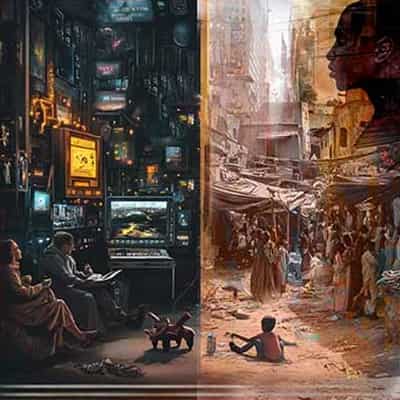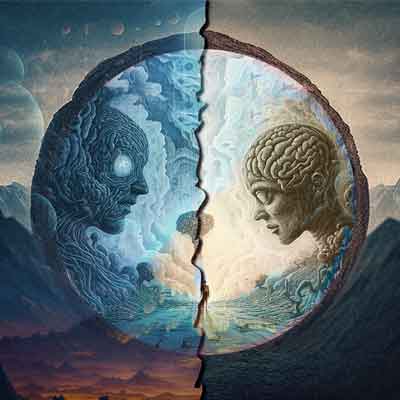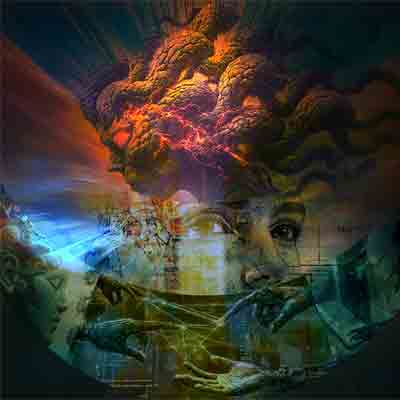From VUCA to BANI: Futurist Jamais Cascio Helps Navigate the New Chaos
Jan. 30, 2025. 20 mins. read.
9 Interactions
Navigating Chaos with Jamais Cascio—Forget the old playbook. The world isn’t just uncertain; it’s brittle, anxious, nonlinear, and incomprehensible.
I’ve been talking with Jamais Cascio off and on for a couple of decades. About a month or so ago, he posted about completing a new book titled Navigating the Age of Chaos: a Sense-Making Guide to a BANI World That Doesn’t Make Sense.
Researching the latest from Jamais, I came across two tropes or memeplexes that I was unfamiliar with – VUCA and BANI. Jamais, who has long been a highly respected thinker and scenario builder in the world of futurists, had shifted much of the discourse from YUCA to BANI. From what to what?
VUCA = Volatility, Uncertainty, Complexity, Ambiguity
BANI = Brittle, Anxious, Nonlinear, Incomprehensible
I will steal a brief biographical note about Jamais from his website: “Selected by Foreign Policy magazine as one of their Top 100 Global Thinkers, Jamais Cascio writes about the intersection of emerging technologies, environmental dilemmas, and cultural transformation, specializing in the design and creation of plausible scenarios of the future.” I will let my email exchange with Jamais take it from here.
RU Sirius: I had heard nothing of VUCA and BANI until I saw your post about completing a book on it. There are so many separate intellectual groupings these days. How would you characterize the people who have been part of this discourse around VUCA and who now are attentive to your new BANI suggestion?
Jamais Cascio: VUCA was developed in the late 1980s at the US Army War College. Through the 90s it was primarily (although not exclusively) a tool for military strategists and planners to think about the larger picture. After 9/11, a whole bunch of business consultants and strategists adopted the language, and within a few years it was the default term to sound smart while talking about the complexities of global existence. Folks at the Institute for the Future, where I had been doing most of my work, had widely adopted the VUCA phrasing and framing.
When I conjured up BANI as a way of giving a better framing for what I saw happening in the world, I didn’t expect it to get much traction. And, to be honest, it didn’t when I first talked about it in late 2018. After COVID-19 hit, a friend who had seen the original presentation pushed me to make it public. I published it on Medium in early April of 2020, and within a few weeks it was getting thousands of hits daily. By late 2020, I was regularly seeing it being used around the world.
With a handful of exceptions, the people who first embraced BANI as a language for making sense of the world came from the Global South. Brazil and Latin America at first, but very quickly South Asia and the Indo-Pacific. To this day, the vast majority of links I see to the BANI concept come from places like India and Malaysia, but I get pings from Russia, Ukraine, China, Vietnam, and more. Most of the places that have started to use BANI as part of their normal strategy (business or political) discussions are places that seem to be facing considerable chaos.
VUCA still gets used quite a bit, and often the two are used in tandem (“Our VUCA-BANI world”). From what I can see, VUCA is still embraced in parts of the world where systems seem to be more functional than not, while BANI has really taken hold in places that seem to be overwhelmed by things.
RU: I’m thinking back to your association with Worldchanging. So much has changed since that time. I think of Worldchanging as having had the thin hope for a utopian or at least broadly positive future and that now you’re talking about navigating dystopia or in fact apocalypse (as represented recently by the LA fires). Would that be an accurate read?
JC: Yes and no. One of the underlying conceits of Worldchanging was that we fully recognized the dire state of the world, but wanted to focus on what could be done about it rather than dwelling on the disasters. Alex Steffen referred to it as “clear-eyed optimism,” and that phrase feels right. But nowhere in the Worldchanging prècis did we underplay how absolutely catastrophic things were starting to be.
BANI builds on that to an extent, as one of my main arguments remains that we have all of the knowledge and tools we need to make a big difference now, but we don’t yet seem to have the desire/will to do so. It’s not a question of waiting for the right technologies – the Singularity is not a sustainability strategy – nor is it a situation where we simply don’t know what we’re facing. We know what’s going on. We know how to push back against disaster. We have not yet chosen to do it.
BANI offers a language for articulating and better-understanding the nature of what’s happening, in part because we can’t resolve a problem if we don’t recognize it, and in part because using a structured understanding of reality helps to understand why much of this chaos seems so unexpected. The difference in tone between Worldchanging and BANI comes from roughly 20 years of seeing the Worldchanging solutions being ignored or denigrated.
Worldchanging told you not to Fuck Around; BANI is when you Find Out.
RU: There’s a possible problem with the notion that we know how to push back but we’re not doing it. It’s the problem of ‘we’. William Burroughs used to always say “there is no we.” There are people with oligarchical wealth and there are all varieties of nation-states and billions of humans married to a wide variety of ideologies, memeplexes, religions etc. So the heavy lift is in the politics… the power and wealth wielded by some, the variations in awareness with everybody else, all that massive complexity… that’s a huge lift! I appreciate the work you’re doing trying to puzzle it all out. I appreciate the emphasis on resilience and empathy. Can you share other strategic thoughts?
JC: I fully agree that the presence and expanding power of oligarchical wealth is one of the big barriers to structural change. And you’re right about the variety of clashing beliefs. I suppose that when I say ‘we’, I mean it in the simplest sense: humankind. Human civilization as a whole.
Outrageous wealth will protect you individually from the dangers of a BANI world, but cannot protect the system upon which your wealth and power is based. A multi-billionaire locked into his safety cave surrounded by robot guards might live out the rest of his life (and you know it would be a “his”) in peace and comfort, but would not be able to do anything with his wealth.
The thing about a global crisis (or, really, overlapping set of crises) is that, eventually, it will affect everyone, even those who can temporarily keep themselves safe. A collapsing Atlantic Meridional Overturning Circulation will not only hurt the poor. Movements driven by misinformation and rage will eventually be enraged at you, too.
In the upcoming BANI book, Navigating the Age of Chaos: A Sense-Making Guide to a BANI World that Doesn’t Make Sense, we talk about both BANI and BANI+, a set of responses to the BANI dynamics, shoehorned into a BANI format, too.
B=Bendable, resilient, flexible, adaptive
A=Attentive, empathetic, accepting, willing to listen
N=Neuroflexible, improvisational, experimental, iterative
I=Interconnected, inclusive, diverse, open
All of these BANI+ ideas boil down to a willingness to be adaptive, to not rely on existing (and increasingly outdated) scripts, to be able to recognize the changes that are happening and not rely on expectations and predictions. BANI shows that our expectations about the world are too often just illusions; BANI+ cautions us to not let our responses be trapped by calcified expectations, too.
Unfortunately, the political winds have made some of these concepts unappealing to some. We had initially considered making the I in BANI+ ‘Inclusive’, but got so much pushback from people we realized that we had to change it.
My most recent Medium piece on BANI puts the responses in the context of seeing the 2024 US election as a BANI event (using older terms before we settled on the final language of BANI+).
RU: I want to push a little more on the political and cultural complexity of dealing with so many different belief systems – and what I would view as toxic belief systems. It appears to block solutions based on human decision-making at a scale that is big enough to address the issues humankind faces. I agree with your earlier comment that waiting around for a Singularity or some great technical hacks to solve our urgent situation is not a good response. But, although we can’t rely on tech solutions, I often think that tech solutions might have more chance of averting pending disasters than the behavior of humans and their institutions. Your thoughts?
JC: I have a couple of immediate responses, then I’ll dig a bit deeper.
The first is that tech solutions are very much a part of how we deal with many of the large-scale global crises, bearing in mind that our technologies are also cultural artifacts. The way our cultures evolve will shape the importance we place on tools and tool capabilities. But, overall, tech of a wide variety is critical and will continue to be.
The second is that over the past decade or so I’ve been doing a bit of what I call ‘foresight forensics’. That is, I look at old forecasts and scenarios that I’ve done, old enough that we’re now roughly in the period those forecasts describe, and compare them to reality.
Right off the bat, I need to tell you that I do not believe that a forecast needs to be “correct” to be useful. Forecasts and scenarios are not meant for investment planning, they’re meant to make the reader more conscious of and sensitive to the nuances of what’s changing in the world.
But at a broad level, the forecasts and scenarios that I’ve worked on have been largely on-target as to the kinds of technological impacts we’ve seen with (e.g.) self-driving cars, ubiquitous networks and cameras, biotech, that sort of thing. Where they’ve been terribly, hilariously wrong, in nearly every case, has been in any forecasts that rely on people changing their behavior to reflect a desire to improve their world and their futures. Some people will do it, but rarely enough to make a real difference, and rarely with improvement as a goal. When we’ve successfully changed behavior, improving the world is usually a side-effect, not the intent.
When I argue that “we” (human civilization as a whole) have the knowledge and the technologies needed to push back against climate catastrophe, resource collapse, etc., the second part of that argument is that we have not demonstrated the will to do so. We can, but will we? That overly-simplistic statement is meant to encapsulate the panoply of forces that work in opposition to global rescue: the ideological, the financial, the geopolitical, the religious, the petty – all of the human forces that focus on gaining advantage now with little attention paid to the future.
The irony is that one of the most visible movements to embrace a long-term perspective is essentially a roundabout argument for doing nothing now. It argues that focusing resources and funds and attention on solving present-day problems slows the advances towards Revolutionary, World-Changing, Transformative super-technologies that will improve billions if not trillions of future lives, someday. It’s pure coincidence that the progenitors of those R,W-C,T super-technologies just happen to be the products and services that will make a narrow set of people even more wealthy today.
I’ve been mulling the question of what has driven the move from a VUCA world to a BANI world. I don’t have any final answers, but a handful of things keep popping up:
the ability to easily see acute manifestations of chronic problems without useful context;
the role of algorithmic curation of media/social media with a focus on increasing advertising revenue; the increasing concentration of wealth and political power into a shrinking number of hands, and the corresponding changes to the economy and culture to favor them;
and all of this in the larger context of environmental systems that have been over-stressed, leading to abrupt disruptions that the other three forces are more likely to worsen than to ameliorate.
This is my gut sense now. It’s not in the Navigating The Age of Chaos book, just (again) something I’m mulling. I’m probably wrong.
RU: When we talk about brittleness and anxiety being defining aspects of our moment, this isn’t just the words of those trying to comprehend the future and make suggestions. These are taxing emotional states that humans are experiencing everywhere. Perhaps it’s even more difficult for people in the West who are accustomed to a certain comfort level. This is not a good way to live. And yet these are the conditions. General thoughts?
JC: You’re correct, and that was the intent. From the beginning, I meant BANI to encompass not just the more abstract aspects of the world, or the big-picture/big-system stuff like climate, but also the lived experiences of people in this world. The inclusion of Anxiety came directly from reading posts by younger people on places like Reddit about what’s going on in their lives, and the very real fear many of them felt about their futures. Brittleness describes the personal experiences as much as it does big systems like democracy or climate. Nonlinear is a fancy way of saying disproportionate (at least in the BANI context), and lots of us feel like our ability to act keeps diminishing as power and wealth become ever more concentrated. And incomprehensible… something I don’t outright say in the book but heavily imply is that “incomprehensible” can be boiled down to the things that happen that make us simply say “what the fuck?”
And yes, it’s taxing. In the book I elaborate quite a bit on how Anxious often manifests as despair. Despair is deadly.
The irony of the present circumstances for the West is that our material lives are (as a whole) better than ever, with better gadgets and services and new ways to do our daily tasks, even as the bigger systems like climate and democracy are collapsing. The deck chairs on the Titanic have never been more beautifully arranged.
But I also make a point of saying that what we’re talking about with all of these crises isn’t apocalypse. It’s not the End of the World, even figuratively. What it will be like, is already like for a rapidly-growing proportion of the planet, is misery. Our lives will be increasingly filled with misery as these systems break and our so-called leaders do nothing but try to figure out how to make a quick buck on the crisis.
RU: And beyond that, do you have any thoughts about how people who have lived through the 20th century with high – or even utopian – expectations, can cope with and maybe even enjoy life in this world as it is?
JC: I saw a comment today about embracing uncertainty. We (as Americans, as folks in the post-industrial world more generally) tend to associate uncertainty with danger – and quite appropriately so, really, if history is any indication. But uncertainty can mean that awful outcomes are not guaranteed. Recognize that better outcomes are possible, but also act to support that outcome happening. I want to be honest… but that usually means that I’m not very reassuring! Right now, any kind of response about ‘enjoying life’ feels like spouting bullshit.
RU: On LinkedIn you asked people how they use BANI in their work. What were one or two of the most interesting responses and why?
JC: I got a few responses with some details, but they mostly boiled down to this (this text is pulled directly from the book draft):
• BANI is a new perspective. Very often those of us who think about the world and try to derive insights get locked into particular mindsets and points of view. They’ve worked before, why wouldn’t they work now? By bringing in a reframing of the situation, one that is simultaneously familiar in structure but novel in perspective, we have an opportunity to look at the set of dilemmas and problems in a new context.
• BANI offers a distressingly accurate depiction of the challenges we face at present, and a likely vision of what the next few decades will hold. It’s not that it tells us something new, necessarily, but it offers a narrative of the world that fits better with what people have been experiencing. It’s more than a tool for business consultants and futurists, it’s a perspective that can be applied to any structured approach at understanding human behavior amidst disruption.
• BANI focuses on the human, emotional aspects of disruptive change. BANI is not quantitative or mechanical; it’s much more about how people – from leaders to citizens – feel about what they are experiencing in a chaotic world. How people feel about their lives is a critical determinant of the decisions they’ll make.
• BANI reflects the sometimes-overwhelming levels of disruption caused by the chaos around us, but frames this disruption as being in the form of dilemmas, not problems. Problems can be solved. Dilemmas usually don’t have a single solution or answer; more often, dilemmas must be responded to in a way that minimizes harm, even while recognizing that the challenges they pose won’t completely go away.
• BANI acknowledges that what we are experiencing is real. BANI reassures people that what they’re seeing, feeling, living through is real. We are often afraid to express our worries, thinking that we may be exaggerating the problems or overreacting to bumps in the road. But what we’re experiencing now and will experience in the years to come does differ from the past.
One thing that needs to be emphasized is that the chaos we’re experiencing is because our crises are combinatorial. It’s not just that we’re seeing a surge in fascism, for example, we’re doing so amidst an acceleration of climate disruption, the metastatic growth of social media influence, the spread of hallucinatory AI into seemingly everything, the biggest land war in Europe since 1945, multiple genocides happening around the world, and more and more. Each of these is a major crisis in and of itself, but they combine and co-evolve in unprecedented ways.

RU: Mindplex Magazine is oriented towards people who are excited about the current hoopla about AI and the possibility of AGI. Can you give us a capsule summary of how you view the current state of AI and where it fits into your scenario? And, if your view is pretty much negative or dismissive, can you think of a way it can be set off in a better direction?
JC: This is a difficult question/set of questions, because there’s both the current state of AI technology and the high-likelihood future versions of AI technology at play here.
With regards to present-day AI, I call LLM systems ‘spicy auto-correct’. We very often see that ChatGPT and Grok and Gemini give answers that may be linguistically correct, with accurate syntax and tense agreement, but completely senseless, because the LLMs don’t understand anything, they provide a viable choice for the next word in a sentence. It’s more sophisticated than your phone’s auto-correct, of course, but it still has a mathematical understanding of language rather than a meaning-based understanding. An AI system arguing that water freezes at 32°F, so it’s still liquid at 27°F, does not actually understand what “freeze” means; it just relies on the statistical likelihood that if a number is a target, a number lower than it hasn’t reached the target conditions.
This should not be surprising. It’s the John Searle Chinese Room argument. The thought-experiment is about a room with a non-Chinese-speaking person with a box of Chinese characters and a set of rules as to which characters to output if a given set of Chinese characters comes in. Searle asks if this person or system is intelligent or knows Chinese. My take is that the room in and of itself is not intelligent, but could well be a component of a larger intelligent system. LLMs are not AGI; they’re at best a possible component of a future AGI.
My main concern about present-day AI (which is largely, but not exclusively, LLM-based) is the way it’s being pushed into everything with a chip, and users are pushed to rely on the technology. Especially given the biases of source data. Especially given the unethical sourcing of data. Especially given the increasing levels of auto-cannibalism. Especially given the likelihood of hallucinations and confabulations, and the overwhelming presence of AI slop (AI-generated books on Amazon, AI-generated images at the top of Google Image search, etc.). AI tools are being put to use in situations where they’re simply not appropriate or really useful. LLMs like ChatGPT should never be used as a search engine, yet Google puts an unavoidable “AI Overview” on many/most of their search results. Then you have situations where the owner of the LLM platform doesn’t like the responses and the changes the rules (Grok!).
And don’t get me started on the energy issues.
And you have multiple examples of CEOs thinking that they can get rid of their mid-level staff (writers, coders, etc.) and replace them with AI – only to find that what they’re getting is crap. It’s not just that AI is a catalyst for job loss, it’s that AI is a catalyst for job loss while (often? usually? nearly always?) doing the job worse.
Present-day AI is bad because it’s made unethically (bias, copyright, energy), used inappropriately, and pushed to unsuspecting and non-consenting users.
With all of that said, this ‘AI-is-bad’ moment is not permanent.
At some point, the bias issue will be compensated for, the source material will be more trustable, the hallucination, and the confabulation problem will be solved (or at least controlled), and the overviews and summaries will actually be accurate.
It remains to be seen whether LLM-based generative AI leads to some version of AGI, but either way advanced LLMs will eventually be useful and accurate enough to do many of the tasks it’s being asked to do now. Moreover, I do believe that AGI is possible, although my suspicion is that it will look nothing like what most people expect. I’m by no means an expert in the subject, but I think that an AGI that is the emergent result of a human-like neural structure – a brain emulation, if you will – is more likely to be recognizable as ‘sapient’ than an AGI built from entirely novel processes.
Real AI/AGI will be transformative. What we have now is more akin to a get-rich-quick bubble of too-often harmful technology.
How to make it all better? For now, my number one answer is stop making it part of everything even vaguely digital. What we have under the flag of ‘AI’ can’t be relied upon to do correctly much of what it’s being tasked to do. That doesn’t mean that it can’t do it, period, but that in too many cases the accuracy of the response can’t be depended upon. And is often unnecessary and wasteful.
#AnticipatoryHistory
#ForesightForensics
#GlobalCrisis
#SystemicCollapse
#TaxonomyofChaos
Let us know your thoughts! Sign up for a Mindplex account now, join our Telegram, or follow us on Twitter.


.png)

.png)


.png)











3 Comments
3 thoughts on “From VUCA to BANI: Futurist Jamais Cascio Helps Navigate the New Chaos”
"Our lives will be increasingly filled with misery." It's scary, but it seems like a probable forecast. I know there will be backlash for saying this, but I’ll say it anyway: misery will be our fate because our present-day capitalism (our new religion) is sick!
Tech was once a solution for our needs, but now it’s a commodity for our wants. Blockchain was once a tool for equality; now, it's a cutting-edge example of a Ponzi Scam. Finance was once a means to our production of goods and services, finance now is a meams to our production of finance. I could go on and on. Our new religion's heaven is excessive profit at any cost—surplus profit! The irony is that surplus profit leads to misery.
🟨 😴 😡 ❌ 🤮 💩
A few thoughts:
LLMs are not designed to evolve into some idiot-savant gods that will deliver us into a Star Trek Utopian Future. There is barely a faint dotted line trail from where we are to that possibility. Rather, they are AKMAs, Aggregated Knowledge Mining Agents. They mine and summarize close affinity tokens in a way that creates the illusion of knowledge, but really just represents the emergent gestalt of previously recorded human thought, for better or worse.
Mostly better for now, but the more LLMs are trained by eating their own tail, the more the approach degrades. This is happening faster than most expected.
What’s needed now are things like context and affinity layers that implement rules to guide and shape the output of these LLMs prior to response.
In the real world at large, the BANI illustrative example of non-linear rapid degradation of our US democracy using agents of chaos and disruption calls out the need for opposing systems designed to restore and maintain order just as quickly. An equally responsive system of order made up of many components, of which human agents and mainstream engagement are key aspects. This requires the will to tirelessly fight disinformation using every tool at our disposal (and many we have not created yet), in order to ensure that more fully engaged democratic voting leads to the replacment of sycophants, tyrants, and sociopaths with intelligent and compassionate leaders willing to uphold the rule of law.
Note:There are many progressives and conservatives both who sincerely want to preserve and enhance our Democracy, and our vision of equality for all. As of this date, we have definitely strayed from that path. We need not only the will, but the means to restore our country to working towards that shared vision.
🟨 😴 😡 ❌ 🤮 💩
This is an excellent discussion. Thank you for the exposure to the BANI concept.
🟨 😴 😡 ❌ 🤮 💩